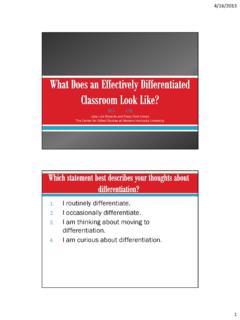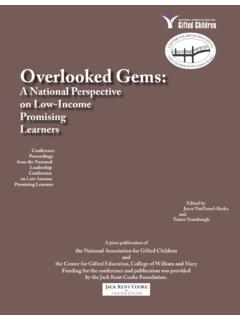Transcription of Unlocking Emergent Talent - nagc.org
1 Unlocking Emergent Talent :Supporting High Achievement of Low-Income, High-Ability StudentsPaula Olszewski-Kubilius and Jane ClarenbachpPaula Olszewski-Kubilius, , is President of the National Association for Gifted Children and Director of the Center for Talent Development at Northwestern University. Jane Clarenbach, , is Director of Public Education at the National Association for Gifted Children. 2012 National Association for Gifted Children | Washington, DC | of ContentsExecutive Summary .. 3 Introduction .. 5 Top-Achieving Students in the United States Today: An Overview.
2 6 Barriers to Participation in Advanced Programs for .. 9 Low-Income, High-Ability StudentsSuccessful Program Models and Practices with ..12 Low-Income, High-Ability StudentsProgram Replication and Scale-Up Challenges ..15 More Than Ability is Required: Psychosocial Issues and ..16 Skills Needed for SuccessPolicies and Action Initiatives to Promote Talent Development ..19 of Low-Income, High-Ability StudentsMoving Towards a New Paradigm: Expanding Our Understanding ..21 of Gifted and TalentedBest Educational Practices with Low-Income, High-Ability Students.
3 22 Research Agenda to Support Low-Income, High-Ability Students ..24 Appendix A: Successful Programs ..27 Appendix B: Summit Participants ..31 Endnotes ..32 Acknowledgments ..35 Unlocking Emergent Talent : Supporting High Achievement of Low-Income, High-Ability Students | 3 pExecutive SummaryUnlocking Emergent Talent : Supporting High Achievement of Low-Income, High-Ability Students takes a comprehensive look at achievement for low-income prom-ising learners past, present, and future. At its core, it challenges the nation to move beyond its near-singu-lar focus of achieving minimum performance for all students, to identifying and developing the Talent of all students who are capable of high achievement, in-cluding our promising low-income and culturally and linguistically diverse students who too often literally languish in our schools.
4 The foundation for this report was built at the National Summit on Low-Income, High-Ability Learners, convened by the National Association for Gifted Children in 2012. The Summit gathered experts to share the latest research on the education and development of low-income, high-ability students, identify barriers to achievement in school and success in adulthood, share information about successful school-based and supplemental programs, and recommend areas in need of further research.
5 After presentations and discussion, participants made recommendations for practice, policy, and research that are based on three general assumptions: Poverty and minority status are not the same. Although there is overlap, poverty manifests differ-ently based on geography, ethnicity, and race. Poverty is pervasive and includes students from rural, White, urban, African American, Hispanic, Asian, and other cultural backgrounds. Typical characteristics of gifted students may mani-fest differently in low-income, high-ability for ActionUnlocking Emergent Talent sets the stage for major strides in both understanding and action, by spot-lighting strong evidence-based program models that produce performance results for low-income, high-ability learners, recommending educational best practices, and identifying both research and public policy gaps that, if filled, could achieve significant re-sults for the future.
6 The report calls on educators and policy makers to: Expect more than proficiency from many more students through policies, funding, and practices that consistently support high expectations and high achievement. Provide multiple strategies to support student achievement at the highest levels, and expand access to rigorous curriculum and supplemental services and programs. Expand preservice and in-service teacher training on identifying and serving high-ability, low-income and culturally and linguistically diverse students. Support Emergent Talent as early as possible, estab-lishing a commitment to achievement at an early age.
7 Engage communities to support in-school learning and supplement curriculum with outside-of-school opportunities Minimize a student s zip code and socioeconomic status as the determining factors for receiving a rigorous, high quality education. Identify successful program models and interven-tions that work with low-income, high-ability students from different geographical, cultural, and racial backgrounds. Remove policy barriers that impede participation and to ExcellenceThe impetus for the National Summit and Unlocking Emergent Talent is the lack of attention to the trou-bling data about student achievement.
8 While our na-tion continues to express commitment to closing the achievement gap, the proportion of low-income stu-4 | National Association for Gifted ChildrenpExecutive Summary dents performing at advanced levels on the National Assessment of Educational Progress exams remains shamefully low. For example, Between 1998 and 2007, or fewer of free and reduced lunch program-eligible students scored at the advanced level on the eighth-grade math exam compared to between 6% and 10% of non-eligible students. Since 1998, 1% or fewer of 4th-, 8th-, and 12th-grade free or reduced lunch students, compared to between 5% and 6% of non-eligible students scored at the advanced level on the civics addition, factors present in school today do little or nothing to improve or sustain top student performance.
9 Equally troubling is that once out of secondary school, high-achieving, low-income students are less likely to attend selective colleges or even graduate from college at all. Unlocking Emergent Talent identifies numerous factors that impede participation in advanced programs by low-income, high-ability students. Too often these children, who typically depend solely on public schools to meet their educational needs, are overlooked by educators and administrators who see high performance on ability or achievement tests as the sole indication of high ability.
10 The type and variety of obstacles are wide ranging, and include policies, perceptions, and pedagogy and curriculum. Identifying Best PracticesDrawing on lessons from successful school-based and supplemental program and service models featured at the Summit, Unlocking Emergent Talent highlights their common factors such as expanded learning time, augmented student support networks, and enriched curriculum, and makes best practice recommenda-tions in identification practices, programs and services, and supportive school cultures.






